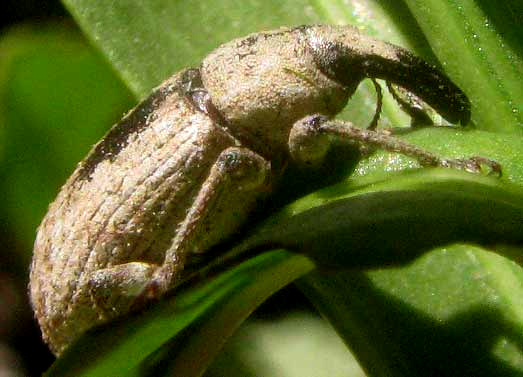Excerpts from Jim Conrad's
Naturalist Newsletter
from the May 11, 2014 Newsletter issued from the Frio Canyon Nature Education Center in the valley of the Dry Frio River in northern Uvalde County, southwestern Texas, on the southern border of the Edwards Plateau; elevation ~1750m (~5750 ft); N29.62°, W99.86°; USA
NOTIODES WEEVIL

Last fall we looked at the Rice Weevils who had taken up residence in my stored rice. You can see that species' long, slender, blunt-tipped snout with antennae arising from the snout's base on our Rice Weevil page at http://www.backyardnature.net/n/a/riceweev.htm.
Since the Rice Weevil's front pair of wings form a hard covering over the cellophane-like hind wings, it's clear that weevils are beetles belonging to the huge Beetle Order, the Coleoptera. And when a beetle is equipped with such a snout with antennae sprouting from its base, it's a member of the Weevil Family, the Curculionidae.
However, the Weevil Family is one of the largest of all animal families, embracing over 40,000 known species, so there are plenty of "variations on the weevil theme."
All these matters coursed through my mind the other day when in the acute angle formed by a leaf attaching to a stem of Water Willow, Justicia americana, emerging from a drying-up pool in the Dry Frio River a weevil-type beetle turned up with his long snout poked into the leaf axil, apparently feeding on soft tissue there. The weevil's basic structure was the same as our previous Rice Weevil's, but this one was much larger, and occupying a profoundly different habitat. Pulling the leaf back to better expose the weevil enabled the picture at the top of this page.
A nice thing about that image is that it shows the tiny open mouth at the very tip of the long, black, blunt snout.
With so many look-alike weevil species, volunteer identifier Bea in Ontario could only hope that by uploading our photo to the wonderful BugGuide.Net website an expert someplace might take a look and give us a name. In a few hours, "v belov," an entomologist in New Jersey, replied: "prob. Erirhininae; need a good dorsal to proceed." In other words, probably it belongs to the weevil subfamily Erirhininae, but to be more certain a picture was needed from directly above, of the "dorsal surface."
My own Internet browsing into the matter makes clear that simply because there are so many possibilities, and distinguishing features often are microscopic, we can't go much further in identifying our weevil.
However, there's so little life-cycle and ecology information on this group that it's a shame to not post what little we have -- that the weevil in the picture was feeding on a Water Willow, Justicia americana, in southern Real County, Texas, in the upper Dry Frio River Valley, on May 4, 2014.
Trying to pin down the identity of our Water Willow feeder and judging from pictures on the Internet, I'd guess that our weevil belongs to the genus NOTIODES. In John LeConte's classic 1876 paper "The Rhynchophora of America North of Mexico," in Proceedings of the American Philosophical Society, partly available through Google Books, our weevil keys out to Notiodes limatulus, based on its body possessing no bristles, and its length, which was 5mm or longer.
Notiodes weevils are sometimes referred to as semiaquatic species, so it sounds right that ours should have been feeding on a Water Willow. Whoever our weevil truly is, here we're filing it on the Internet under "Notiodes limatulus" in the hope that someday a researcher will be pleased to find this page, and maybe either confirm or correct our ID.